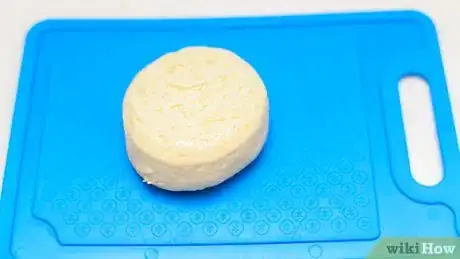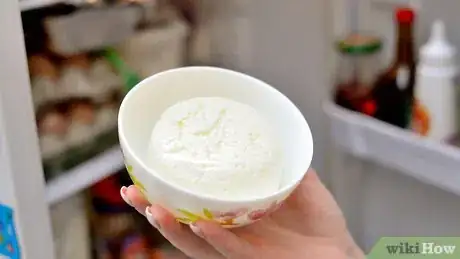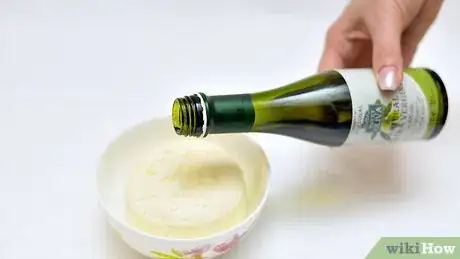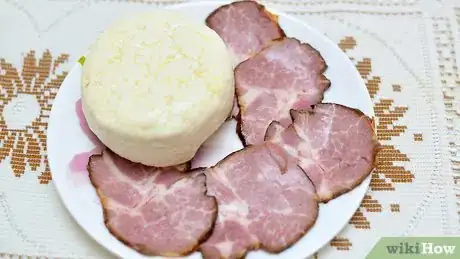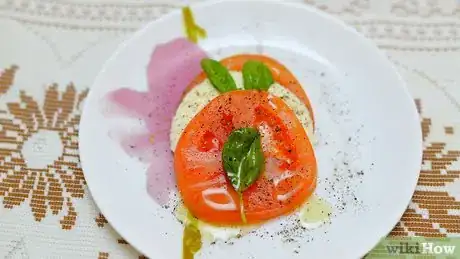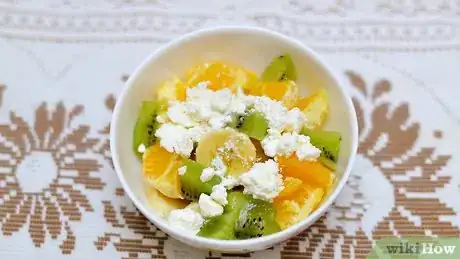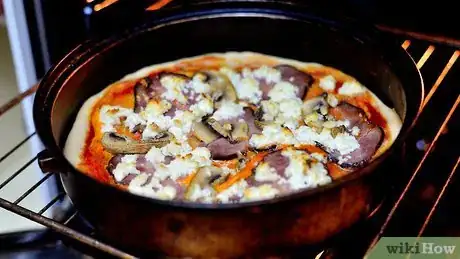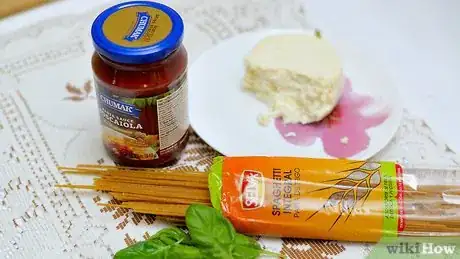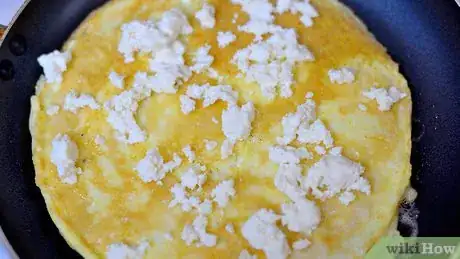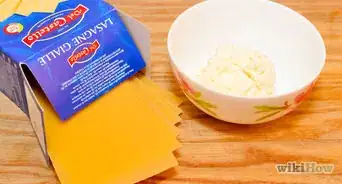This article was co-authored by wikiHow staff writer, Amber Crain. Amber Crain has been a member of wikiHow’s writing staff for the last six years. She graduated from the University of Houston where she majored in Classical Studies and minored in Painting. Before coming to wikiHow, she worked in a variety of industries including marketing, education, and music journalism. She's been a radio DJ for 10+ years and currently DJs a biweekly music program on the award-winning internet radio station DKFM. Her work at wikiHow supports her lifelong passion for learning and her belief that knowledge belongs to anyone who desires to seek it.
There are 14 references cited in this article, which can be found at the bottom of the page.
This article has been viewed 32,670 times.
Learn more...
Burrata is a soft, Italian cheese typically eaten fresh. It typically comes in a round shape, with a mozzarella shell and a cream or soft curd filling. You can eat burrata by itself or on a slice of bread as a simple snack or meal. Its mild, buttery flavor also works well in a fruit or vegetable salad, on top of pizza or pasta, or baked into any dish where you’re looking for a creamy, cheesy touch.
Steps
Enjoying Burrata on Its Own
-
1Choose the freshest possible burrata. This cheese contains a lot of water, which evaporates quickly. Your burrata will be less creamy the longer you wait to eat it. Try to find cheese that was made within the past day, if possible.[1]
- Burrata can be found in specialty grocery stores or cheese shops. If your local store has a dairy counter, ask them when the burrata was made so you know it’s fresh.
-
2Store the cheese in the fridge and eat it within 48 hours for the best flavor. Burrata will stay fresh longer if it’s stored at 40 °F (4 °C). Even stored in the fridge, however, burrata is best eaten within 48 hours. You can eat it past this point, but it might not be as good.[2]
- If you need to store it longer, keep burrata in its own brine and store it in your fridge for up to a week.
Advertisement -
3Take the cheese out of the fridge 30 minutes before serving it. A half hour to an hour before you want to enjoy the burrata, set it out at room temperature so it can warm up a little. This will ensure that the creamy center of the burrata is not too solid.[3]
- You can also put your cheese in a bowl of warm water for 10 minutes to warm it up. Most burrata comes in a small bag, so you can place that directly in the water. Make sure to drain it well before you serve the cheese![4]
-
4Place your burrata in a bowl, and top with olive oil and salt. It’s better to serve this cheese in a bowl rather than a plate, because when you cut into it the curd at the center will spill out. Drizzle a small amount of high-quality olive oil onto the burrata and sprinkle a bit of salt on top to enhance the burrata’s flavor.[5]
- Wait to cut into the burrata until you serve it so everyone can immediately dig in to the fresh curd.
- Adjust the amount of salt you add based on your own preferences. Burrata doesn’t have a strong flavor to begin with, but if you’re only getting a mild milk flavor and not much else, a small amount of salt can help the flavor stand out more.[6]
-
5Serve burrata with cured meats and a slice of crusty bread. For a simple snack or light meal, just spread the cheese on a piece of bread. Use toasted bread, or one with a tougher crust, to get a nice contrast in textures with the creamy burrata.[7] The cheese’s mild flavor also pairs excellently with the saltiness of cured meats like prosciutto.
- To toast bread, slice a baguette into 1⁄2 inch (1.3 cm) slices and bake for 5 minutes at 400 °F (204 °C). Flip over each slice, bake another 5 minutes, and brush with olive oil once it’s done.[8]
- You can also brush slices of bread with olive oil and heat them in a griddle pan or skillet until they’re lightly browned.
Using Burrata in Recipes
-
1Pair burrata with meats, fruits, or vegetables on a piece of crostini. For an easy appetizer, snack, or light meal, toast or grill slices of baguette or ciabatta bread, and add burrata and any other toppings you might like. Try to find ingredients with contrasting flavors or textures.
- Add burrata, roasted eggplant slices, chorizo, and chili peppers to toast. Sprinkle salt, pepper, thyme, and lemon zest on top.
- Layer prosciutto slices, burrata, and a slice of fresh fig.[9]
- Pile burrata, chopped Brussels sprouts, radicchio, pine nuts, and apple pieces on a crostini slice.[10]
- Smear burrata onto a piece of toast, and top with honey or fruit jam.[11]
-
2Top a traditional salad with burrata. Burrata’s mild, buttery flavor and creamy texture works great with a wide variety of fresh vegetables. Try slicing up some in-season produce, sprinkle with salt and pepper, and add a few pieces of hand-torn burrata.
-
3Add burrata to fruit dishes for a savory kick. Think of burrata like you would other soft cheeses and dairy products, like cottage cheese or even yogurt. Add fruits, granola, and honey to make a sweet breakfast dish.[14] You can also combine burrata with fresh fruit salad for a simple snack or dessert.[15]
- Burrata works especially well as a topping for sliced stone fruit, such as peaches and plums.
- Try making sweet summer salad by roasting beets and blanching peaches, then add burrata, olive oil, and salt. Top it all off with pistachios for a crunchy finish.
-
4
-
5Top pizza with burrata when the pizza is almost finished cooking. Add pizza sauce, other cheeses, and toppings to rolled-out pizza dough. Bake at 500 °F (260 °C) for 10 minutes. Then, tear the burrata into small pieces, sprinkle them on top of the pizza, and bake for another 3 or 4 minutes.[18]
- Using 1 cup (120 g) of cheese to top a pizza is pretty typical, but you can adjust the amount depending on your preference.
- Try also adding prosciutto, fresh chopped basil, and red pepper flakes once you’re done baking the pizza.
- Try burrata on a pizza along with pancetta, roasted tomatoes, onions, and arugula.[19]
-
6Add chunks of burrata to pasta dishes. Cook pasta according to package directions, and then add your preferred sauce. Once the pasta is done, tear pieces of burrata into chunks and sprinkle them on top of your pasta.[20]
- Finish pasta with a basic tomato sauce, burrata, and fresh basil leaves.
- Use burrata in lasagna for extra creaminess. When making the lasagna, top your ricotta cheese layer with burrata chunks.[21]
-
7Add burrata to egg dishes at the end of the cooking process. Use burrata like you would other cheeses, keeping in mind that it doesn’t need much time to melt. The cheese’s creaminess can enhance soft, custardy eggs.
- Place a couple small pieces of burrata on top of or inside of an omelet.
- Serve burrata balls along side poached eggs.[22]
References
- ↑ https://www.thekitchn.com/whats-the-difference-between-mozzarella-and-burrata-word-of-mouth-219642
- ↑ https://www.thekitchn.com/whats-the-difference-between-mozzarella-and-burrata-word-of-mouth-219642
- ↑ https://www.finedininglovers.com/blog/food-drinks/burrata-cream-mozzarella/
- ↑ https://leitesculinaria.com/99556/recipes-burrata.html
- ↑ https://leitesculinaria.com/99556/recipes-burrata.html
- ↑ https://www.cooksillustrated.com/articles/688-tasting-burrata
- ↑ https://www.thekitchn.com/whats-the-difference-between-mozzarella-and-burrata-word-of-mouth-219642
- ↑ https://www.splendidtable.org/recipes/crostini
- ↑ https://www.azestybite.com/fig-prosciutto-burrata-crostini/
- ↑ http://www.chicagotribune.com/suburbs/ct-ppn-where-to-eat-burrata-tl-1026-20171020-story.html
- ↑ https://www.myrecipes.com/extracrispy/how-to-eat-burrata-for-breakfast
- ↑ https://www.foodiecrush.com/burrata-and-heirloom-tomato-caprese-salad/
- ↑ https://www.myrecipes.com/extracrispy/how-to-eat-burrata-for-breakfast
- ↑ https://www.myrecipes.com/extracrispy/how-to-eat-burrata-for-breakfast
- ↑ https://www.abeautifulplate.com/beet-peach-burrata-salad-with-basil-oil-and-candied-pistachios/
- ↑ http://www.chicagotribune.com/suburbs/ct-ppn-where-to-eat-burrata-tl-1026-20171020-story.html
- ↑ https://food52.com/recipes/35945-roasted-carrots-with-carrot-top-pesto-and-burrata?utm_source=cj&affil=cj&utm_medium=affiliate&utm_campaign=Food52+Shop&company=Skimlinks&website=7597874&cjevent=5c6c2459c1d911e883ee01270a240611
- ↑ http://whatsgabycooking.com/burrata-pizza-pie/
- ↑ http://www.chicagotribune.com/suburbs/ct-ppn-where-to-eat-burrata-tl-1026-20171020-story.html
- ↑ http://iamafoodblog.com/one-pot-pasta-tomato-basil-and-burrata-spaghetti/
- ↑ https://www.howsweeteats.com/2016/01/roasted-vegetable-lasagna-with-burrata/
- ↑ https://www.myrecipes.com/extracrispy/how-to-eat-burrata-for-breakfast
- ↑ https://www.thekitchn.com/whats-the-difference-between-mozzarella-and-burrata-word-of-mouth-219642
- ↑ http://www.chicagotribune.com/suburbs/ct-ppn-where-to-eat-burrata-tl-1026-20171020-story.html
